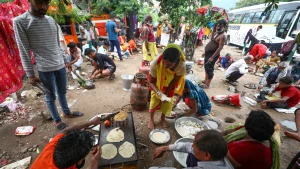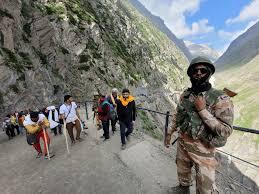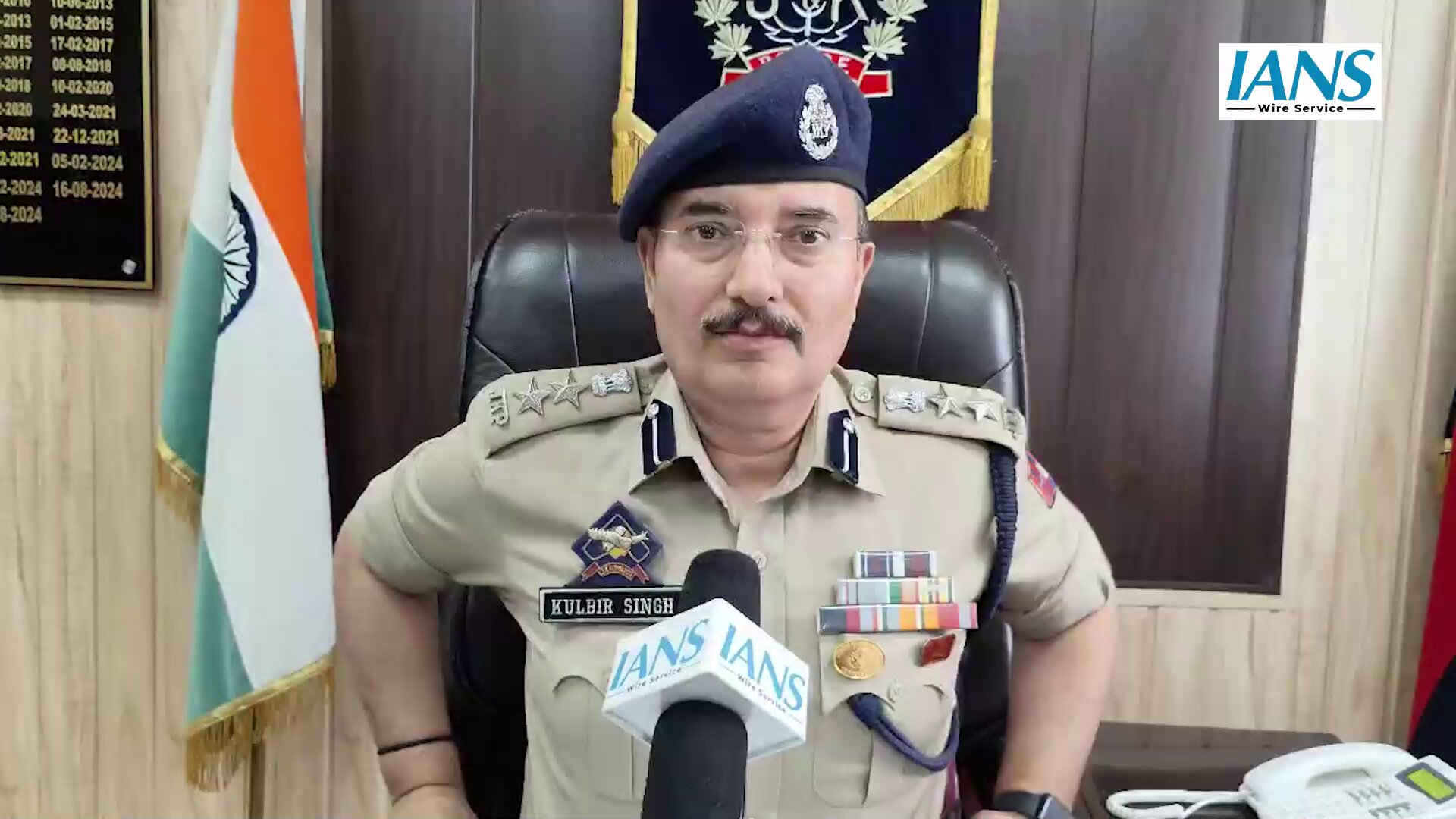Jammu – The sacred journey of Amarnath Yatra took a tragic turn on Saturday morning when an Amarnath Yatra Bus Collision left 36 pilgrims injured in the Chanderkote area of Ramban district. The accident occurred during what should have been a routine breakfast stop, transforming a peaceful moment of the pilgrimage into a scene of chaos and emergency response.
The Tragic Incident Unfolds

The Amarnath Yatra Bus Collision occurred in the early hours of Saturday morning when a convoy of buses carrying devotees to the holy Amarnath shrine had stopped for their scheduled breakfast break. The accident took place in the Chanderkote area, a designated halt point where pilgrims typically rest and refresh themselves during their spiritual journey.
According to Senior Superintendent of Police (SSP) Ramban, Kulbir Singh, the Amarnath Yatra Bus Collision was caused when one bus in the convoy failed to stop in time and rammed into four stationary buses from behind. This initial impact created a devastating chain reaction that resulted in injuries to dozens of devoted pilgrims who had been looking forward to completing their sacred journey.
The Amarnath Yatra Bus Collision highlights the challenges faced by large convoys navigating the mountainous terrain of Jammu and Kashmir. The winding roads and frequent stops required for such long journeys create situations where vehicle control becomes critical for passenger safety.
Details of the Accident
The circumstances surrounding the Amarnath Yatra Bus Collision paint a picture of a routine stop gone terribly wrong. The convoy had been proceeding normally toward the Amarnath shrine when they reached the designated breakfast halt at Chanderkote. As is customary during the pilgrimage, the buses had parked in formation to allow pilgrims to disembark, stretch their legs, and have their morning meal.
However, the Amarnath Yatra Bus Collision occurred when the trailing bus in the convoy apparently experienced difficulties in stopping. The vehicle crashed into the rear of the stationary buses, creating a domino effect that involved a total of five buses and resulted in injuries to 36 pilgrims.
Also Read: BJP Leader Gopal Khemka Murder: Businessman Shot Dead Outside Patna Home
The force of the Amarnath Yatra Bus Collision was significant enough to cause injuries across multiple vehicles, though fortunately, most of the injuries were reported to be minor in nature. The timing of the accident, during a breakfast stop when many pilgrims may have been outside their vehicles, potentially prevented even more serious casualties.
Immediate Response and Rescue Operations


Following the Amarnath Yatra Bus Collision, emergency response teams swung into action to provide immediate medical assistance to the injured pilgrims. The remote location of Chanderkote in Ramban district presented logistical challenges, but rescue operations were quickly organized to ensure all injured passengers received proper medical attention.
Local authorities coordinated the rescue efforts following the Amarnath Yatra Bus Collision, with medical teams being dispatched to the scene to assess and treat the injured pilgrims. The mountainous terrain of the region required careful planning to evacuate those with more serious injuries while providing on-site treatment for those with minor injuries.
The response to the Amarnath Yatra Bus Collision demonstrated the preparedness of local emergency services for such incidents during the pilgrimage season. The organized nature of the rescue operations helped ensure that medical care reached the injured pilgrims in a timely manner, preventing the situation from becoming more severe.
Extent of Injuries and Medical Response


SSP Kulbir Singh provided crucial information about the casualties from the Amarnath Yatra Bus Collision, stating that “pilgrims suffered minor injuries, majority of them willing to continue their pilgrimage after first aid.” This positive assessment indicated that while the accident was serious, the majority of those affected would be able to recover quickly.
However, the Amarnath Yatra Bus Collision did result in some more significant injuries. SSP Singh noted that “three to four of the injured may not be able to proceed further due to the nature of their injuries.” These cases required more intensive medical attention and would unfortunately prevent these pilgrims from completing their spiritual journey.
The medical response to the Amarnath Yatra Bus Collision involved both immediate first aid treatment at the scene and arrangements for more comprehensive medical care for those with serious injuries. The differentiation between minor and more serious cases allowed medical teams to prioritize their response effectively.
Impact on the Pilgrimage


The Amarnath Yatra Bus Collision occurred during one of the most sacred periods for Hindu pilgrims, when thousands of devotees make the challenging journey to the Amarnath cave shrine. The accident raised concerns about the safety measures in place for the large convoys that transport pilgrims through the mountainous terrain of Jammu and Kashmir.
Despite the Amarnath Yatra Bus Collision, the determination of the pilgrims was evident in their desire to continue their spiritual journey. The fact that the majority of injured pilgrims expressed willingness to continue their pilgrimage after receiving first aid demonstrates the deep spiritual significance of the Amarnath Yatra for devotees.
The Amarnath Yatra Bus Collision also highlighted the resilience of the pilgrimage system, with authorities working to ensure that the accident did not disrupt the overall flow of the yatra. Emergency protocols were activated to manage the situation while maintaining the sanctity and continuity of the pilgrimage.
Safety Concerns and Preventive Measures
The Amarnath Yatra Bus Collision raises important questions about vehicle safety and convoy management during the pilgrimage season. The mountainous roads of Jammu and Kashmir present unique challenges for large vehicles, particularly when frequent stops are required for rest and refreshment.
Following the Amarnath Yatra Bus Collision, authorities will likely review safety protocols for convoy operations. The accident demonstrates the need for enhanced vehicle maintenance checks, driver training, and potentially improved spacing between vehicles during stops to prevent similar chain reaction accidents.
The Amarnath Yatra Bus Collision also underscores the importance of having robust emergency response systems in place during the pilgrimage season. The quick response to this incident showed the value of prepared emergency services, but also highlighted areas where improvements might be made.
Ongoing Investigation and Analysis
The Amarnath Yatra Bus Collision will require a thorough investigation to determine the exact cause of the accident and to identify measures that could prevent similar incidents in the future. Factors such as vehicle condition, driver alertness, road conditions, and convoy management procedures will all need to be examined.
The investigation into the Amarnath Yatra Bus Collision will likely focus on understanding why the trailing bus failed to stop in time. Whether this was due to mechanical failure, driver error, or other factors will be crucial in developing preventive measures for future pilgrimages.
Final Statement
The Amarnath Yatra Bus Collision serves as a sobering reminder of the challenges faced during one of India’s most important religious pilgrimages. While the majority of injured pilgrims were able to continue their journey after receiving first aid, the incident highlights the need for continued vigilance and improved safety measures to protect the thousands of devotees who undertake this sacred journey each year. The resilience shown by the pilgrims and the efficient response of emergency services demonstrate the strength of both faith and preparedness in the face of adversity.

